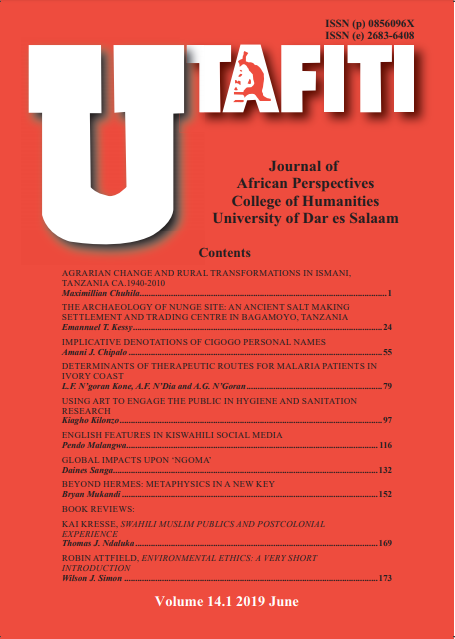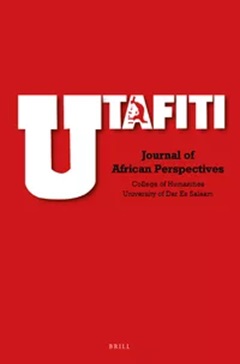AGRARIAN CHANGE AND RURAL TRANSFORMATION IN TANZANIA: ISMANI, CIRCA 1940-2010
Abstract
Farming is a major sector of informal employment for more than 67 per cent of the active labour force in Tanzania. This means farming is of primary importance to the overall economy. Rural transformations and the future of agriculture in Tanzania depend mainly upon improved access to market outlets, guarantees on improved seeds, and availability of farm-loans. These are essential interventions to transform the rural sector despite the challenges it is facing. An overview of government interventions in future rural development policy and activity is offered here by focusing on Ismani, part of the present-day Iringa District in the Southern Highlands of Tanzania. Agrarian change in Ismani through the 1940s to the 1970s depended upon government interventions on the one hand, and changes in the physical environment on the other. Initially during this period, Ismani became a national food granary in the 1970s as a result of government interventions. Then this progress turned upside down in the 1980s, when the development of Ismani took on a new dimension due to a rapid decline in maize productivity. In recent years, especially over the last two decades, Ismani has experienced recurrent food insecurity. Evidence of the drastic change emerges from reliance on archival sources, fieldwork interviews and secondary sources collected in 2012, 2013 and 2017. This paper explores the dynamics of maize farming in Ismani, to provide a detailed historical understanding of how a prosperous maize farming area can become, in the space of only a few years, an area which is now rife with localised food insecurity in many of its villages.
Keywords: rural modernisation, agriculture, Ismani, development, maize farming, Ujamaa.
References
Anderson, D. 2002. Eroding the commons: the politics of ecology in Baringo, Kenya, 1890s-1963. London: James Currey.
Anderson, D. and Throup, D. 1985. Africans and agricultural production in colonial Kenya: the myth of the war as a watershed. The Journal of African History 26.4: 327-345.
Awiti, A. 1975. Ismani and the rise of capitalism. In: Rural Cooperation in Tanzania. Eds. L. Cliff et al. Dar es salaam: Tanzania Publishing House, 51-78.
Ayo, S. 2017. Tobacco farming and its influence on the social cultural transformation in Urambo District, Western Tanzania, 1950s to 2010. Unpublished MA dissertation, University of Dar es Salaam.
Bjerk, P. 2015. Building a peaceful nation: Julius Nyerere and the establishment of sovereignty in Tanzania, 1960-1964. Rochester: University of Rochester Press.
Bluwstein, J. et al. 2018. Between dependence and deprivation: the interlocking nature of land alienation in Tanzania. Journal of Agrarian Change 18(4): 806-830.
Bowles, B.D. 1980. The political economy of colonial Tanganyika 1939-1961. In: Tanzania under colonial rule. Ed. M.H. Kaniki. London: Longman Group.
Bunge la Tanzania [Tanzania Parliament]. 2010. Twentieth Parliamentary Summit. Thirteenth Session. 22 June.
Bryceson, D. F. 2010. Agrarian fundamentalism or foresight? Revisiting Nyerere ' s vision for rural Tanzania. In: Tanzania in transition: from Nyerere to Mkapa. African Books Collective. Eds. K.J. Havnevik and A.C. Isinika. Dar es Salaam: Mkuki na Nyota, pp. 71-98.
Chuhila, M. J. 2013. Maize farming and environmental change in Iringa District: the case of Ismani, 1940-2010. Unpublished MA dissertation, University of Dar es Salaam.
Chuhila, M. J. 2016. Coming down the mountain: a history of land use change in Kilimanjaro, ca. 1920 to 2000s. Unpublished PhD thesis, University of Warwick.
Chuhila, M.J. 2019. ' To plan is to choose ' : Navigating Nyerere ' s Economic and Political Thoughts, 1961-1980s. In: From African peer review mechanisms to African queer review mechanisms? Robert Mugabe, empire and decolonization of African orifices. Eds. Artwell Nhemachena and Tapiwa V. Warikandwa. Bamenda, Cameroon: Langaa RPCIG, pp. 387-404.
Coulson, A. 2013. Tanzania: a political economy. Second edition. New York: Oxford University Press.
Friis-Hansen, E. 1987. Changes in land tenure and land use since villagisation and their impact on peasant agricultural production in Tanzania: the case of the southern highlands. Copenhagen: Centre for Developmental Research.
Fuggles-Couohman, N. R. 1964. Agricultural change in Tanganyika: 1945-1960. Redwood City: Stanford University Press.
Havnevik, K. 1993. Tanzania: the limits to development from above. Uppsala: Nordic Africa Institute.
Havnevik, K. 2010. A historical framework for analysing current Tanzanian transitions: the post-independence model, Nyerere ' s ideas and some interpretations. Dar es Salaam: Mkuki na Nyota, pp. 19-56.
Helleiner, G. K. 1968 [1966]. Agricultural Export Pricing Strategy in Tanzania. East African Journal of Rural Development 1(1) January. Also available as ERB Paper No. 66.6. Dar es Salaam: Economic Research Bureau, University of Dar es Salaam.
Hogendorn, J. S. and K. M. Scott. 1981. Very large scale agricultural projects: the lessons of the East African groundnut scheme. African Economic History 10: 81-115.
Hyden, G. 1980. Beyond Ujamaa in Tanzania: underdevelopment and uncaptured peasantry. Nairobi: Heinemann.
Iliffe, J. 1979. A modern history of Tanganyika. Cambridge: Cambridge University Press.
Illife, J. 1971. Agricultural change in modern Tanganyika: an outline. Nairobi:East African Publishing House.
Jennings, M. 2007. ' A Very Real War ' : Popular Participation in Development in Tanzania during the 1950s & 1960s. International Journal of African Historical Studies 40.1: 71-95.
Kikula, I. S. 1999. Lessons from twenty-five years of conservation and seven years of research initiatives in the Kondoa highlands of central Tanzania. Ambio: A Journal of the Human Environment 28(5): 444-449.
Kjærby, F. 1986. The development of agricultural mechanisation in Tanzania. In: Tanzania crisis and struggle for survival. Ed. J.B. Kjell, J.Havnevik, J. Koponen, R. Odgaard. Uppsala: Scandinavian Institute of African Studies, pp. 173-191.
Kjekshus, H. 1977a. The Tanzanian villagisation policy: implementational lessons and ecological dimensions. Canadian Journal of African Studies/La Revue canadienne des études africaines 11(2): 269-282.
Kjekshus, H. 1977b. Ecology control and economic development in East African history: the case of Tanganyika 1850-1950. Athens: Ohio University Press.
Lawi, Yusuf Q. 2000. May the spider web blind witches and wild animals: Local knowledge and the political ecology of natural resource use in the Iraqwland, Tanzania, 1900-1985. Unpublished PhD thesis, Boston University, Massachusetts.
Lawi, Yusuf .Q. 2007. Tanzania ' s operation vijiji and local ecological consciousness: the case of eastern Iraqwland, 1974-1976. The Journal of African History 48(1): 69-93.
Lofchie, M.F. 2018. The murder of Wilbert Kleruu: collective agriculture on trial in Tanzania. Journal of Eastern African Studies 12(4): 754-771.
Luanda, N.N. 1986. European commercial farming and its impact on the Meru and Arusha peoples of Tanzania 1920-1955. Unpublished PhD thsis, University of Cambridge, United Kingdom.
Mbunda, R. 2016. The developmental state and food sovereignty in Tanzania. Agrarian South: Journal of Political Economy 5(2-3): 265-291.
Mohele, A.T. 1975. The Ismani maize credit programme. Dar es Salaam: Economic Research Bureau, University of Dar es Salaam.
Msambichaka, L. A. and Robert B. Mabele. 1974. Agricultural credit and the development of Ujamaa villages in Tanzania. Economic Research Bureau, University of Dar es Salaam.
Ndomba, H.H. 2014. The Ruvuma development association and Ujamaa in Songea District, 1960s-1990s. Unpublished MA dissertation, University of Dar es Salaam.
Nindi, B. C. 1977. A historical study of the cooperative movement in Tanzania. Transafrican Journal of History 6: 64-78.
Nindi, B. C. 1978. Agricultural change and rural class formation in Iringa district, Tanzania. Unpublished PhD thesis. University of Hull, United Kingdom.
Nindi, B. C. 1985. Agriculture change in Tanzania: with examples from Iringa region. Transafrican Journal of History 14: 101-111.
Nyerere, J. K. 1968. Ujamaa: essays on socialism. Oxford: Oxford University Press.
Ostrom, E. 2015. Governing the commons. Cambridge: Cambridge University Press.
Schneider, L. 2004. Freedom and unfreedom in rural development: Julius Nyerere, Ujamaa vijijini, and villagisation. Canadian Journal of African Studies/La Revue canadienne des études africaines 38(2): 344-392.
Schneider, L. 2014. Government of development: peasants and politicians in postcolonial Tanzania. Bloomington: Indiana University Press.
Scott, J. C. 1998. Seeing like a state: how certain schemes to improve the human condition have failed. New Haven: Yale University Press.
Sulle, E. 2015. Land grabbing and agricultural commercialization duality: insights from Tanzania ' s transformation agenda. Afriche e Orienti 17(3): 109-128.
Sumra, S. 1975. Problems of agricultural production in Ujamaa villages in Handeni District. Dar es Salaam: Economic Research Bureau, University of Dar es Salaam.
Swai, B. 1979. The labour shortage in 1930s Kilimanjaro and the subsequent employment of child labour. Utafiti: Journal of the College of Arts and Sciences 4.2: 111-132.
Swai, B. 1980. Tanganyika and the great depression 1929-1936. Transafrican Journal of History 9(1-2): 192-225.
Taasisi ya Elimu. 1983. Wafanyakazi wa Tanzania: jiografia kwa darasa la nne, kitabu cha wanafunzi. [Tanzania ' s workforce: Geography. Fourth grade student reader.] Dar es Salaam: Wizara ya Elimu ya Taifa.
Tanganyika Territory. 1944. Ordinances enacted during the year 1943. Dar es Salaam: Government Printer.
Tanganyika African National Union [TANU]. 1972. Siasa ni kilimo [Politics is agriculture]. Dar es salaam: Government Printer.
The United Republic of Tanganyika and Zanzibar (URT). 1964. Tanganyika Five-year plan for economic and social development. 1 July 1964 - 30 June 1969. Volume I (General Analysis). Dar es Salaam: Government Printer.
Tosh, J. 1980. The cash-crop revolution in tropical Africa: an agricultural reappraisal. African Affairs 79(314): 79-94.
Twining, L. 1959. The last nine years in Tanganyika. African Affairs 58(230):15-24.



